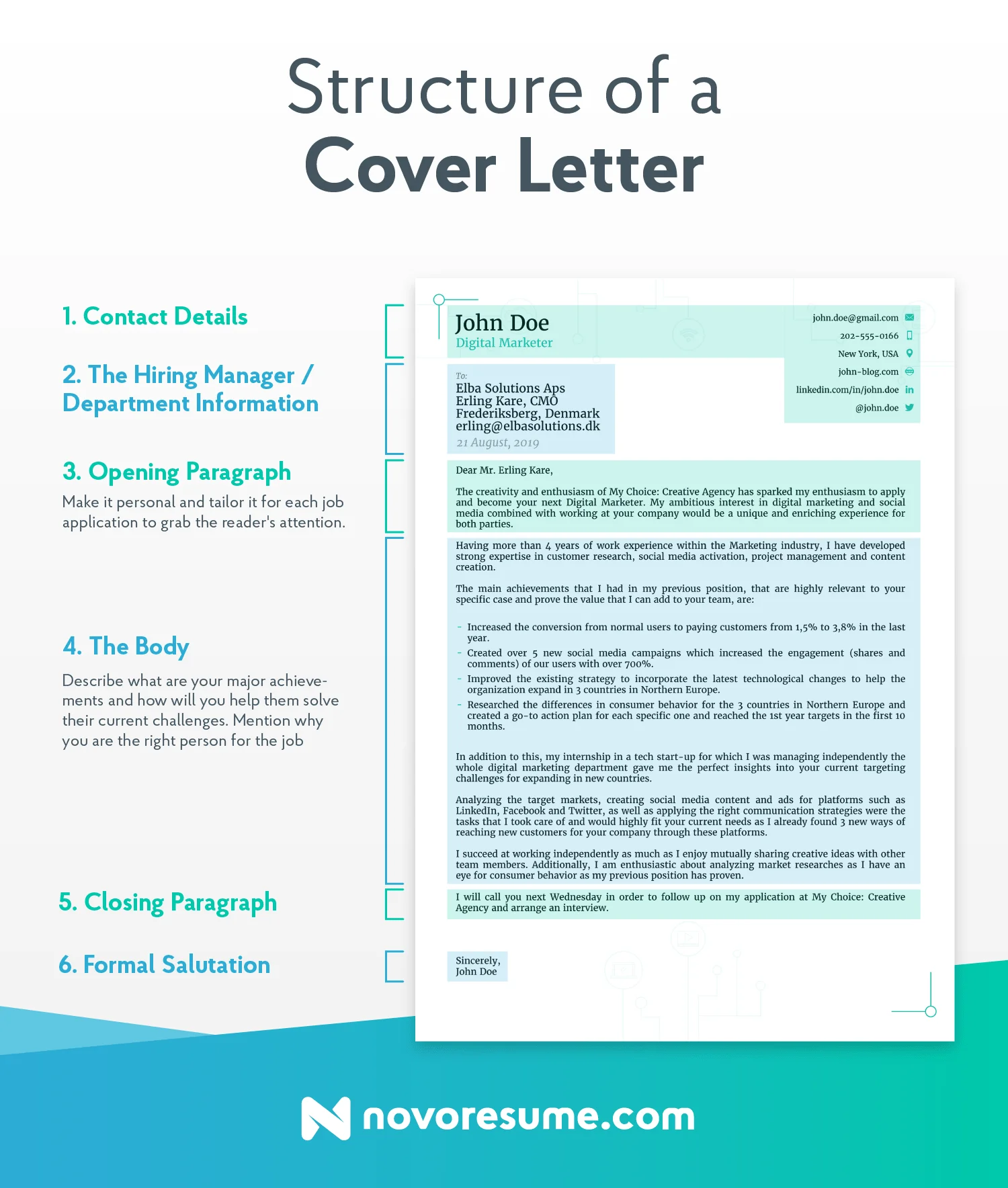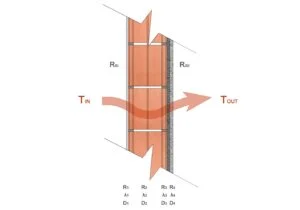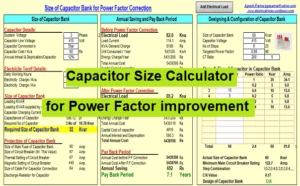
Give someone who knows nothing about cooking the ingredients to a perfect meal and you’ll end up with a disorganized, very possibly inedible, meal.
The same disorganized, quite possibly tasteless, fate awaits your cover letter if you don’t know how to properly format it.
Getting the cover letter format right is the same as having those coveted cooking skills that can turn the right ingredients into a meal that leaves you wanting more.
Now, if you’re wondering whether your formatting skills are enough to impress recruiters, there’s no need to worry.
This article is going to show you exactly how to format a cover letter the right way.
Here’s what we’re going to cover:
- What Should Go On a Cover Letter?
- How to Format Your Cover Letter
- (Free) Cover Letter Templates You Can Use
- How to Format Your Cover Letter When Sending It Via Email
So let’s get right to it!
The Best Cover Letter Format – What Goes on a Cover Letter
Your cover letter’s format is both how your cover letter looks and how it’s structured.
So, cover letter formatting includes everything from page margins, spacing, and font size to how long your cover letter should be, how many paragraphs it should have, and what each paragraph should contain.
Pretty substantial, if you ask us – which is exactly why we’ll go over these elements one by one. Before we do, however, let’s first get the essentials out of the way.
What exactly goes into a cover letter? The short answer is as follows:
- A header, which contains your contact information and the employer’s or recruiter’s contact information.
- A greeting to the recruiter and the opening paragraph, which you want to use to grab the reader’s attention.
- The body of your cover letter, which is between 1-3 paragraphs.
- A closing paragraph, which usually contains a call to action.
- A formal salutation.
And here’s what that looks like in practice:

A Look into Your Cover Letter Format, by Section
In theory, all these rules are pretty straightforward…
But if you’ve ever written a cover letter before, you’ll probably agree with us that actually writing one ain’t all that simple.
In this section, we’ll take you through the entire process of creating a cover letter, section by section!
Starting with:
#1. Header
Your cover letter’s header should contain your contact info, the date, and the hiring manager’s or employer’s contact info.
If you’re wondering which contact information you should include and which you should leave out, here are the essentials:
- Full name and professional title (where applicable)
- Phone number
- Name and professional title of the hiring manager
- Name of the company you’re applying to
- Company address
Here’s a visual representation of this:

Quick Tip
If you want to know more about header formatting, such as what you can optionally include and what you should definitely leave out, head over to our guide on how to start a cover letter.
#2. Greeting
After listing your contact information, it’s time to address the cover letter.
First things first: the impersonal and overly popular “To Whom It May Concern” and “Dear Sir/Madam” are yesterday’s news. They’re impersonal and just about every other applicant uses them.
And you want your cover letter to stand out, right?
So, greet the hiring manager directly, instead. For example:
Correct Examples:
Dear Mr. Brown,
Dear Mrs. Waldorf,
If, however, you are unsure about their title, gender, marital status, or pronouns, use their entire name to avoid any mistakes, such as:
Correct Examples:
Dear Alex Brown,
Dear Blair Waldorf,
Alternatively, the recruiter may hold a title, such as Doctor, Professor, or sergeant, or you might be addressing a letter without a contact person.
In such cases, here are some do-s and don’t-s to keep in mind:
Correct Examples:
Dear John Doe,
Dear Mr./Mrs. Doe,
Dear Dr. Leonard,
Dear Rev. Owen,
Dear Marketing Hiring Team,
Dear Director of Marketing,
Incorrect Examples:
To Whom It May Concern,
What’s Up Hiring Team,
Dear Sir/Madam,
Hey John,
Hi there Hiring Team,
#3. Opening Paragraph
The opening paragraph of your cover letter is where the recruiter first gets to really hear your voice. As such, you’ve got to make it count and grab their attention before they move on to the next applicant.
And how exactly do you do that? Well, for starters, avoid being generic. You don’t want your opening paragraph to sound as if you’re applying to dozens of jobs with the same letter.
Instead, you want your opening paragraph to mention:
- Your name, profession, and years of experience.
- 1-2 of your top achievements (to help you stand out).
- The name of the firm and position you’re applying for.
Here’s what this would look like in a cover letter:
Right Example:
Dear Mary,
My name is Ellen and I’d like to join Company X as a marketing expert. I believe that my 5+ years of experience as a marketing specialist, as well as my skills in PPC management and copywriting, will help me drive new users to your platform Additionally, I believe that my past experience in the financial industry will help me excel at the role.Quick Tip
Struggling with writing your own cover letter introduction? Check out our guide on how to start a cover letter effectively!
#4. Cover Letter Body
The body of your cover letter usually consists of 1-3 paragraphs and is where you convince the recruiter that you’re the right person for the job.
We have a few pointers to help you do that:
- Don’t just rehash your CV. The recruiter already read it. Instead, use your cover letter to elaborate on your achievements and back them up with even more evidence.
- Understand the job requirements. Check the requirements for the position in the job listing, see how you can match them with your strengths and qualifications, and use the body of your cover letter to show you’re a good fit for the job.
- Research the company. Also important is to show that you match the company’s culture. Read up about the company you’re applying for and learn what’s their product/service, what are they known for, what kind of culture they have, and so on. Then, in your cover letter, mention a bit about the company’s culture and talk about how you’re a good fit.
And here’s hows the body of your cover letter would look like in practice:
Right Example:
In my previous role as a Marketing Expert, I also handled the company’s Digital Marketing. During the course of one year, I managed the company’s monthly Facebook ad budget, which amounted to $20,000+ and the process of ad creation and management end-to-end. The process involved creating ad copies, images, picking out the targeting, running optimization trials, and so on.
In addition to Facebook advertising, I am also knowledgeable in other Pay Per Click channels, such as:
I actually learned a lot about PPC management basics from your company YouTube channel, and really admire how you guys manage your ad accounts. Since I’m already familiar with how Company X handles ads, I believe that I’d be able to really excel at the role.
#5. Closing Paragraph (And a Call to Action)
Now, how you end a cover letter is just as important as how you start it.
As you wrap up your cover letter, it’s important to do the following:
- Mention anything that you couldn’t in the previous paragraphs. If you have anything left to say, mention it here.
- Thank the hiring manager for their time. Good manners go a long way.
- Finish the cover letter with a call to action. Your cover letter’s last sentence should be a call to action, such as asking the hiring manager to take some sort of action.
Here’s an example of that:
Correct Example:
In conclusion, thank you for considering my application. I hope I have the chance to help your company take its marketing initiatives to the next level. It would be great to discuss how my experience so far can make that a reality.
As for your formal salutation, you can use any of the following “tried and tested” greetings:
- Best Regards,
- Kind Regards,
- Sincerely,
- Thank you,
Cover Letter Format Guide
We went over what goes in your cover letter section by section. However, how your cover letter looks on the outside is just as important.
Following some standard formatting tips will show the hiring manager that you took the time and put in the effort to hand in the best version of a cover letter, which is sure to help your case.
Here are the rules that you need to follow:
- Keep your cover letter between half and one page in length to make sure the recruiter actually reads the whole thing (if you had to read 100+ cover letters, you’d want applicants to stick to one page too). That’s between 250-400 words long.
- Use 1 or 1.5 line spacing throughout your text, and double spacing between paragraphs.
- Go for a simple and readable font and set your font size to 11 or 12 pts. Using custom fonts may seem like a good idea, but there’s no guarantee the hiring manager’s computer will have that specific font installed.
- Save your cover letter in PDF format to make sure the layout stays the same despite the type of software or Operating System (OS) that opens it.
Or Choose One of Our Cover Letter Templates
The cover letter is an inseparable part of any application package. As such, you want your cover letter format to be as impeccable as possible.
And while the formatting rules we’ve listed above aren’t complicated to follow, you’d rather not take any risks with your cover letter format.
Want to make sure that your cover letter format is impeccable?
Just use a cover letter template!
The format is done for you – all you have to do is fill in the contents.

Sending Your Cover Letter Via Email? Here’s How To Do It!
It’s safe to assume that nowadays, most cover letters are sent via email. That means that you’re probably submitting your email in one of two ways:
- Sending it as an email attachment.
- Uploading it to the company’s webpage.
If that’s the case, you’re good with the formatting rules listed above.
If, however, you’re sending your cover letter in the body of the email, here’s what you need to do differently:
- Write a professional subject line. The best and safest formula is “Name – Position you’re applying to” (e.g. “Helen Simms – Application for Marketing Expert Position”).
- Remove the header. As the hiring manager’s contact details and the date are no longer necessary, remove the header altogether and place your contact information underneath the formal salutation.
- Look out for typos. Check your cover letter and then double-check it. Typing on a keyboard can be tricky; sometimes, a typo might just be a matter of fast typing. Avoid that by being extra careful.
And you’re about ready to press “Send.”
Key Takeaways
Your cover letter format is a big part of the impression your job application can make. As such, it’s important to get the formatting right.
Here are the main points this article covers to achieve that:
- Make sure to structure your cover letter the right way.
- Address your cover letter the right way and write an attention-grabbing opening paragraph.
- Wrap up your cover letter with a call to action.
- Pay attention to the margins, space lining, font size, and cover letter length.
- If you’re sending your cover letter as the body of your email, make sure to tweak the formatting accordingly.
Courtesy: novoresume

